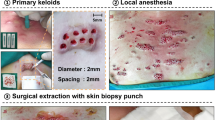Abstract
Background
Polyacrylamide hydrogel (Aquamid), an atoxic non-immunogenic gel of the non-resorbable type, has gained widespread popularity as an injectable filler for facial augmentation. However, adverse events (AEs) have occurred, the nature of which seems obscure because of negative findings on culture and a pattern of foreign-body response on microscopy.
Design
This is a prospective study of case reports provided by physicians injecting Aquamid during the period 21 May 2001 to 15 September 2003.
Materials
Among 40,000 persons injected, 55 were reported to have experienced AEs. Information from questionnaires distributed along with the product and follow-up information from involved physicians was collected into a database.
Results
AEs occurring mainly in lips and nasolabial folds were reported in 55 patients, with 51 requiring treatment. The time from the last gel injection to the debut of the AE varied from 2 to 364 days, with a median of 12 days. Seventeen patients presented with different types of reaction to the injection, and the exact cause of the AE was established in another 19. A complete follow-up until full recovery was available in only 43 cases (84%). A broad-spectrum antibiotic in high dosage was effective for a short time. Steroids and non-steroidal anti-inflammatory drugs (NSAIDs) tended to aggravate symptoms and to prolong treatment time.
Conclusions
AEs presenting clinically as nodules or swellings later than 1 week and less than 1 year after the injection of polyacrylamide hydrogel (Aquamid) should be treated immediately with a broad-spectrum antibiotic (quinolone) in high dosage. Steroids or NSAIDs are contraindicated.


Similar content being viewed by others
References
Allen O (1992) Response to subdermal implantation of textured microimplants in humans. Aesthetic Plast Surg 16:227
Bergeret-Galley C, Latouche X, Illouz Y-G (2001) The value of a new filler material in corrective and cosmetic surgery: DermaLive and DermaDeep. Aesthetic Plast Surg 25:249
Bollen L (2000) Intracutaneous test in the rabbit. Scantox, Denmark (Lab. No. 40771)
Boye K, Hogdall E, Borre M (1999) Identification of bacteria using two degenerate 16S rDNA sequencing primers. Microbiol Res 154:23
Breiting V, Aasted A, Jørgensen A, Opitz P, Rosetzsky A (2004) A study on patients treated with polyacrylamide hydrogel injection for facial corrections. Aesthetic Plast Surg 28:45
Christensen LC, Breiting VB, Aasted A, Jørgensen A, Kebuladze I (2003) Long term effects of polyacrylamide hydrogel (PAAG, Interfall/Contura SA) in human breast tissue. Plast Reconstr Surg 111:1883
Duranti F, Salti G, Bovani B (1998) Injectable hyaluronic acid for soft tissue augmentation: a clinical and histological study. Dermatol Surg 24:1317
Ersek RA, Beisang AA (1991) Bioplastique: a new textured copolymer microparticle promotes permanence in soft tissue augmentation. Plast Reconstr Surg 33:693
Hennekes R, Garus HJ (1989) Orbitale spätkomplikationen nach subkutaner silikoninjektion. Fortschr Ophthalmol 86:249
Lemperle G, Gauthier-Hazan N, Lemperle M (1998) PMMA microspheres (Artecol) for long lasting correction of wrinkles: Part III. Refinements and statistics. Aesthetic Plast Surg 2:356
Lemperle G, Romano JJ, Busso M (2003) Soft tissue augmentation with Artecol I: 10-year history, indications, technique and complications. Dermatol Surg 29:573
Lupton JR, Alster TS (2000) Cutaneous hypersensitivity reaction to injectable hyaluronic acid. Dermatol Surg 26:135
Maas CS, Papel ID, Greene D, Stoker DA (1997) Complications of injectable synthetic polymers in facial augmentation. Dermatol Surg 23:871
McCollister DD, Hake CL, Sadek SE, Rowe VK (1965) Toxicological investigations of polyacrylamides. Toxicol Appl Pharmacol 7:639
Mendez-Eastman SK (2003) BOTOX: a review. Plast Surg Nurs 23:64
Netscher DT, Weizer G, Wigoda P, Walker LE, Thornby J, Bowen D (1995) Clinical relevance of positive breast periprosthetic cultures without overt infection. Plast Reconstr Surg 96:1125
Pearl RM, Laub DR, Kaplan EN (1978) Complications following silicone injections for augmentation of the contour of the face. Plast Reconstr Surg 61:888
Rapaport MJ, Vinnik C, Zarem H (1996) Injectable silicone: cause of facial nodules, cellulites, ulceration and migration. Aesthetic Plast Surg 20:267
Requena C, Izquierdo MJ, Navarro M, Martinez A, Vilata JJ, Botella R, Amorrortu J, Sabater V, Aliaga A, Requena L (2001) Adverse reactions to injectable aesthetic microimplants. Am J Dermatol 23:197
Rudolph CM, Soyer P, Schuller-Petrovic S, Kerl H (1999) Foreign body granulomas due to injectable aesthetic microimplants. Am J Surg Pathol 23:113
Smith EA, Oehma FW (1991) Acrylamide and polyacrylamide: a review of production, use, environmental fate and neurotoxicity. Rev Environ Health 9:215
Stegman SJ, Chu S, Armstrong RC (1998) Adverse reactions to bovine collagen implant: clinical and histologic features. J Dermatol Surg Oncol 14(Suppl 1):39
Travis WD, Balough K, Abraham JL (1985) Silicone granulomas: report of three cases and review of the literature. Hum Pathol 16:19
Virden CP, Dobke MK, Stein P (1992) Subclinical infection of the silicone breast implant surface as a possible cause of capsular contracture. Aesthetic Plast Surg 16:173
Webster RC, Fuleihan NS, Hamdan US, Fuleihan NS, Giandello PR, Smith RC (1986) Injectable silicone: report of 17,000 facial treatments since 1962. Am J Cosmet Surg 3:41
Wilkie TF (1977) Late development of granuloma after liquid silicone injections. Plast Reconstr Surg 60:179
Acknowledgements
Ieva Ankorina-Stark, M.Sc., Ph.D. and Professor Henrik Enghusen Poulsen, M.D., Ph.D., are gratefully acknowledged for valuable comments and recommendations.
Author information
Authors and Affiliations
Corresponding author
Additional information
The authors have no relevant financial interest in this study
Rights and permissions
About this article
Cite this article
Christensen, L., Breiting, V., Vuust, J. et al. Adverse reactions following injection with a permanent facial filler polyacrylamide hydrogel (Aquamid): causes and treatment. Eur J Plast Surg 28, 464–471 (2006). https://doi.org/10.1007/s00238-005-0005-2
Received:
Accepted:
Published:
Issue Date:
DOI: https://doi.org/10.1007/s00238-005-0005-2




